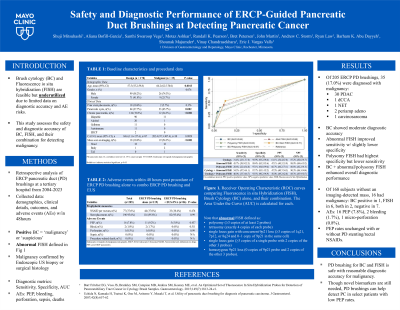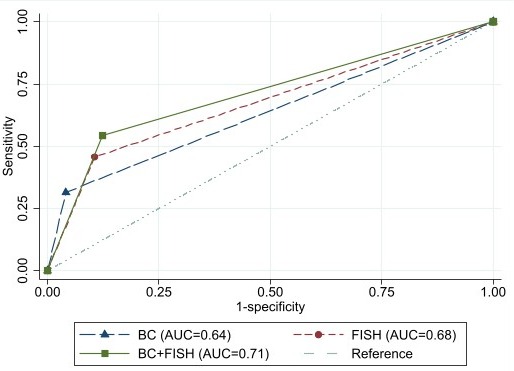Monday Poster Session
Category: Biliary/Pancreas
P1727 - Safety and Diagnostic Performance of ERCP-Guided Pancreatic Duct Brushings at Detecting Pancreatic Cancer
Monday, October 28, 2024
10:30 AM - 4:00 PM ET
Location: Exhibit Hall E

Has Audio

Shuji Mitsuhashi, MBBS
Mayo Clinic
Rochester, MN
Presenting Author(s)
Shuji Mitsuhashi, MBBS, Aliana Bofill-Garcia, MD, Santhi Vege, MD, Motaz Ashkar, MBBS, Randall Pearson, MD, Bret Petersen, MD, John Martin, MD, Andrew Storm, MD, Ryan Law, DO, Barham Abu Dayyeh, MD, Shounak Majumder, MD, Vinay Chandrasekhara, MD, Eric J. Vargas, MD, MS
Mayo Clinic, Rochester, MN
Introduction: Pancreatic duct (PD) brush cytology (BC) and Fluorescence in situ hybridization (FISH) are technically feasible but have limited adoption in clinical practice due to insufficient data on their diagnostic accuracy for pancreatic cancer (PC) and the risk of adverse events (AEs). This study aims to evaluate the safety and diagnostic performance of BC, FISH, and their combination in detecting malignancy.
Methods: A retrospective analysis was conducted on subjects who underwent ERCP PD brushings at a single tertiary hospital. Demographics, clinical information, procedural details, AEs within 48hr post-procedure, and outcomes were collected. Positive BC was defined as “malignancy” or “suspicious,” while positive FISH criteria are specified in Fig 1. Combined BC and FISH positivity was considered if either test indicated malignancy. Malignancy was confirmed by Endoscopic Ultrasound (EUS)-guided tissue sampling or surgical histology. Diagnostic metrics (sensitivity, specificity, and Area under the Curve (AUC)) were calculated. AEs included post-ERCP pancreatitis (PEP), bleeding, perforation, sepsis, and deaths.
Results: Of the 205 subjects who underwent ERCP PD brushings from 2004 to 2023, 35 (17.0%) were diagnosed with malignancy, including 30 pancreatic adenocarcinomas, 1 distal cholangiocarcinoma, 1 neuroendocrine tumor, 2 periampullary adenocarcinomas, and 1 carcinosarcoma. BC had a sensitivity of 31.4% and a specificity of 95.8% (AUC 0.64) in diagnosing malignancy, while FISH had a sensitivity of 45.7% and a specificity of 89.4% (AUC 0.68). The combined BC and FISH approach demonstrated a sensitivity of 54.3% and a specificity of 87.7% (AUC 0.71) (Fig. 1). Of the 168 subjects (81.9%) without an imaging-detected mass, 16 were diagnosed with malignancy: 1 had positive BC, 6 had positive FISH, 2 were positive for both, and 7 were negative for both. AEs included 16 cases (7.8%) of PEP, 2 cases (1.7%) of bleeding, and 1 case (0.8%) of micro-perforation (Table 1). There were no differences in the incidence of PEP between those who received PD stenting and/or rectal NSAIDs and those who did not.
Discussion: PD brushing for BC and FISH is generally safe with reasonable diagnostic accuracy for malignancy. While novel diagnostic tests such as molecular biomarkers in pancreatic fluid for detecting PC are still needed, in select patients PD brushings can assist in the detection of PC with low rates of PEP.

Note: The table for this abstract can be viewed in the ePoster Gallery section of the ACG 2024 ePoster Site or in The American Journal of Gastroenterology's abstract supplement issue, both of which will be available starting October 27, 2024.
Disclosures:
Shuji Mitsuhashi, MBBS, Aliana Bofill-Garcia, MD, Santhi Vege, MD, Motaz Ashkar, MBBS, Randall Pearson, MD, Bret Petersen, MD, John Martin, MD, Andrew Storm, MD, Ryan Law, DO, Barham Abu Dayyeh, MD, Shounak Majumder, MD, Vinay Chandrasekhara, MD, Eric J. Vargas, MD, MS. P1727 - Safety and Diagnostic Performance of ERCP-Guided Pancreatic Duct Brushings at Detecting Pancreatic Cancer, ACG 2024 Annual Scientific Meeting Abstracts. Philadelphia, PA: American College of Gastroenterology.
Mayo Clinic, Rochester, MN
Introduction: Pancreatic duct (PD) brush cytology (BC) and Fluorescence in situ hybridization (FISH) are technically feasible but have limited adoption in clinical practice due to insufficient data on their diagnostic accuracy for pancreatic cancer (PC) and the risk of adverse events (AEs). This study aims to evaluate the safety and diagnostic performance of BC, FISH, and their combination in detecting malignancy.
Methods: A retrospective analysis was conducted on subjects who underwent ERCP PD brushings at a single tertiary hospital. Demographics, clinical information, procedural details, AEs within 48hr post-procedure, and outcomes were collected. Positive BC was defined as “malignancy” or “suspicious,” while positive FISH criteria are specified in Fig 1. Combined BC and FISH positivity was considered if either test indicated malignancy. Malignancy was confirmed by Endoscopic Ultrasound (EUS)-guided tissue sampling or surgical histology. Diagnostic metrics (sensitivity, specificity, and Area under the Curve (AUC)) were calculated. AEs included post-ERCP pancreatitis (PEP), bleeding, perforation, sepsis, and deaths.
Results: Of the 205 subjects who underwent ERCP PD brushings from 2004 to 2023, 35 (17.0%) were diagnosed with malignancy, including 30 pancreatic adenocarcinomas, 1 distal cholangiocarcinoma, 1 neuroendocrine tumor, 2 periampullary adenocarcinomas, and 1 carcinosarcoma. BC had a sensitivity of 31.4% and a specificity of 95.8% (AUC 0.64) in diagnosing malignancy, while FISH had a sensitivity of 45.7% and a specificity of 89.4% (AUC 0.68). The combined BC and FISH approach demonstrated a sensitivity of 54.3% and a specificity of 87.7% (AUC 0.71) (Fig. 1). Of the 168 subjects (81.9%) without an imaging-detected mass, 16 were diagnosed with malignancy: 1 had positive BC, 6 had positive FISH, 2 were positive for both, and 7 were negative for both. AEs included 16 cases (7.8%) of PEP, 2 cases (1.7%) of bleeding, and 1 case (0.8%) of micro-perforation (Table 1). There were no differences in the incidence of PEP between those who received PD stenting and/or rectal NSAIDs and those who did not.
Discussion: PD brushing for BC and FISH is generally safe with reasonable diagnostic accuracy for malignancy. While novel diagnostic tests such as molecular biomarkers in pancreatic fluid for detecting PC are still needed, in select patients PD brushings can assist in the detection of PC with low rates of PEP.

Figure: Figure 1. Receiver Operating Characteristic (ROC) curves comparing Fluorescence in situ Hybridization (FISH), Brush Cytology (BC) alone, and their combination. The Area Under the Curve (AUC) is calculated for each. Note that positive FISH defined as: polysomy (≥3 copies of at least 2 probes), tetrasomy (exactly 4 copies of each probe), single locus gain with concurrent 9p21 loss (≥3 copies of 1q21, 7p12, or 8q24 and 0–1 copy of 9p21 in the same cell), single locus gain (≥3 copies of a single probe with 2 copies of the other 3 probes), or homozygous 9p21 loss (0 copies of 9p21 probe and 2 copies of the other 3 probes).
Note: The table for this abstract can be viewed in the ePoster Gallery section of the ACG 2024 ePoster Site or in The American Journal of Gastroenterology's abstract supplement issue, both of which will be available starting October 27, 2024.
Disclosures:
Shuji Mitsuhashi indicated no relevant financial relationships.
Aliana Bofill-Garcia indicated no relevant financial relationships.
Santhi Vege indicated no relevant financial relationships.
Motaz Ashkar indicated no relevant financial relationships.
Randall Pearson indicated no relevant financial relationships.
Bret Petersen indicated no relevant financial relationships.
John Martin indicated no relevant financial relationships.
Andrew Storm: Apollo Endosurgery – Consultant, Grant/Research Support. Boston Scientific – Consultant, Grant/Research Support. Enterasense – Grant/Research Support. Intuitive Surgical – Consultant. Olympus – Consultant. SofTac – Grant/Research Support.
Ryan Law: boston scientific – Consultant, Grant/Research Support. Olympus – Consultant, Grant/Research Support.
Barham Abu Dayyeh indicated no relevant financial relationships.
Shounak Majumder indicated no relevant financial relationships.
Vinay Chandrasekhara indicated no relevant financial relationships.
Eric Vargas: Philips – Grant/Research Support.
Shuji Mitsuhashi, MBBS, Aliana Bofill-Garcia, MD, Santhi Vege, MD, Motaz Ashkar, MBBS, Randall Pearson, MD, Bret Petersen, MD, John Martin, MD, Andrew Storm, MD, Ryan Law, DO, Barham Abu Dayyeh, MD, Shounak Majumder, MD, Vinay Chandrasekhara, MD, Eric J. Vargas, MD, MS. P1727 - Safety and Diagnostic Performance of ERCP-Guided Pancreatic Duct Brushings at Detecting Pancreatic Cancer, ACG 2024 Annual Scientific Meeting Abstracts. Philadelphia, PA: American College of Gastroenterology.

